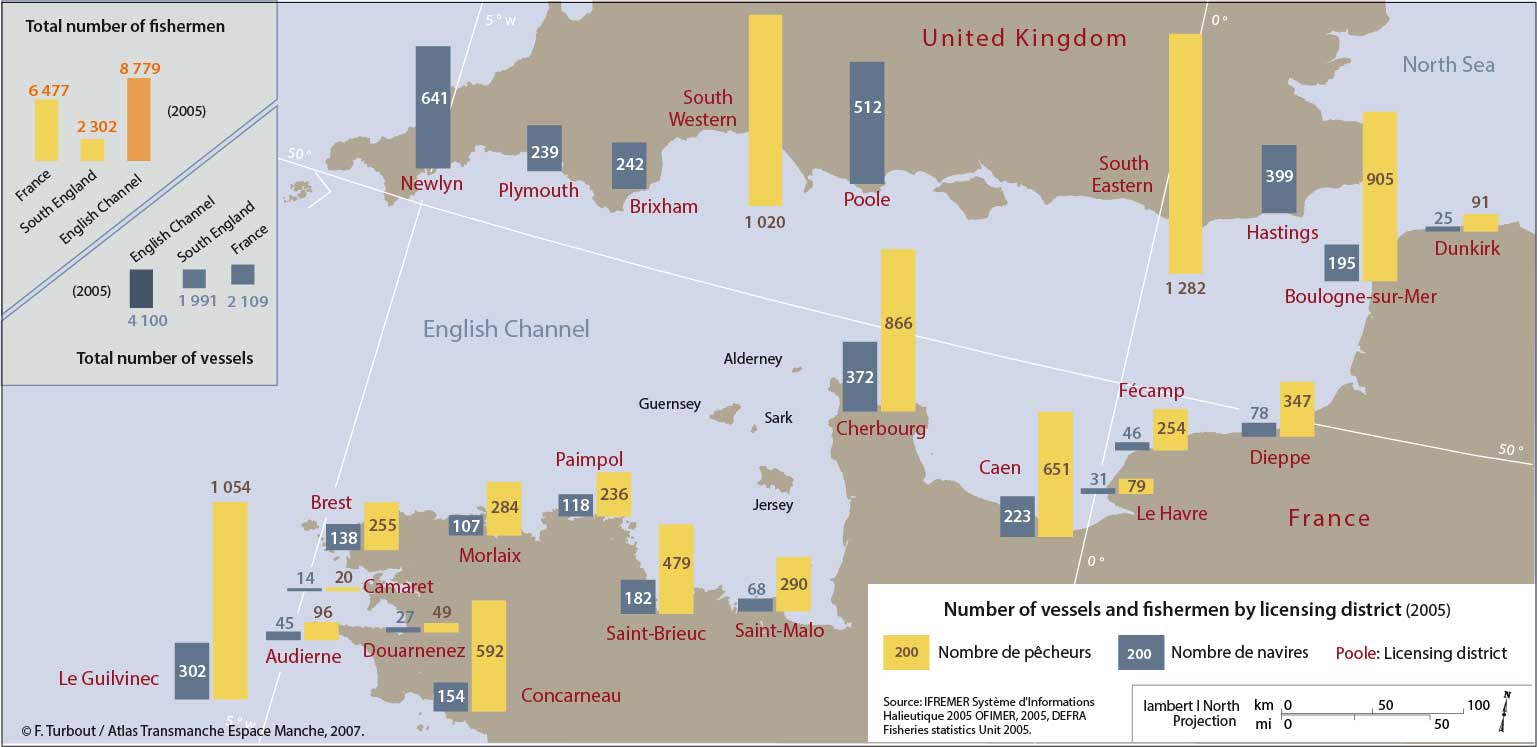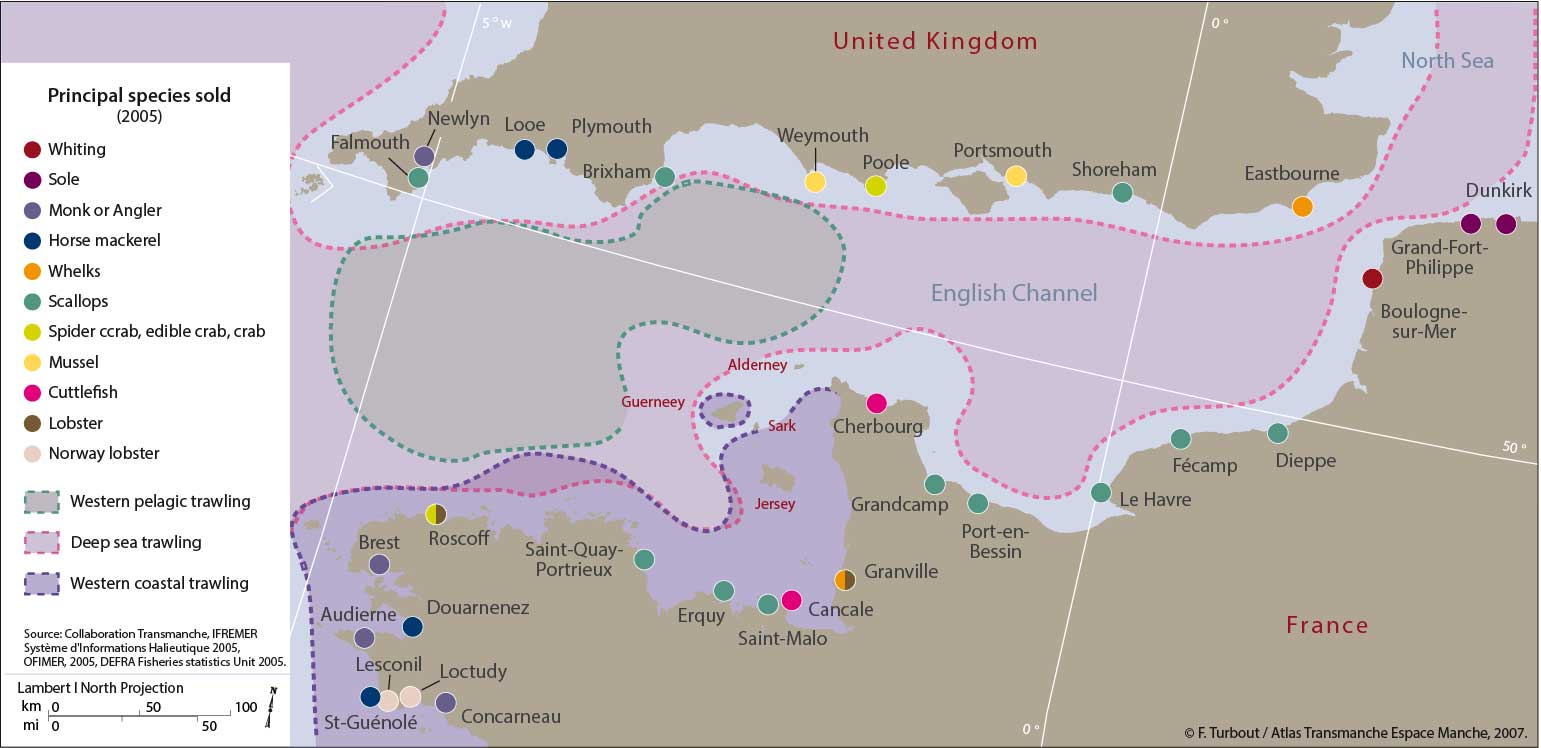

 2000
2000- Fishing (2003-2005)
- Pêche (2003) : la flotte et les hommes FR
Of all the human activities that are practised on either side of the English Channel, fishing is incontestably one of the oldest and most deeply anchored. On both sides of the Channel, there is a long standing tradition of sea-going people forming the core of small local societies that are long established and firmly rooted in their fishing port; a culture of long sea journeys, of various ports of call, of differences that have grown up and identities shared by men confronted by the elements, and constantly faced with the possibility of their own or their neighbours' imminent death. Fishing, the mode of livelihood, the economics of the activity, its integration into society, and the ways all these are represented have changed considerably over the centuries, and even over the last few decades. Nevertheless, there is a constant theme running through all these generations: a proximity with and a dependence upon the elements, although techniques have reduced their impact. There is a relationship between the natural resource and the mental representation of men of the sea, both themselves and in the wider society.
Since motorisation and the organisation of wider marketing opportunities, that is to say since the inter-war years and, even more, since the Second World War, fishing has experienced very profound changes: the radical and absolute transformation of markets, the increasing value of fish, new fishing and navigational techniques, pressure on the natural resource, the economic status of the profession, and so on. Today, the question of the resource, its conservation, the economic conditions of the majority of fishermen and the position of fishing in relation to other activities are some of the most pressing of the issues under debate.
There are a very large number of fishing ports around the Channel, from Newlyn and Falmouth, the most westerly on the Cornish peninsula, facing Brest and Roscoff, to Hastings and Boulogne. The largest, of which there are around forty, are slightly more numerous on the French coast than on the English side. The statistical regrouping by district should not allow ports such as Erquy, Granville, Grandcamp, Port-en-Bessin, or Honfleur to be forgotten; these fisheries are still very much alive. To the ports that have the necessary installations, markets, auction halls, and professionals involved in commerce and monitoring, must be added the string of smaller ports where fishing activities, although often more widespread in the past, are still practised today, although in a more limited, residual way. There are still some fishing boats beyond the tip of Cornwall, in the Isles of Scilly, as there are in Molène and Batz, or on the Isle of Wight.
2 300 boats are currently active in the Channel's seaports. Most of them work exclusively in the Channel, which accounts for over 60% of their catch and income, with a total production of 220 000 tons (2004). Around this core of activity in the Channel by professional fisheries should be added another 10% of Belgian, Dutch, and German boats that come to fish in the Channel, accounting for a little over 200 craft, plus another 200 coming from the French ports on the Atlantic seaboard.
Two thirds of the fishing in the Channel is coastal (at sea for over 24 h) or inshore fishing (under 24 h). Deep-sea fishing is carried out by boats over 16 m long, with Boulogne as the main port for this category. For coastal and inshore fishing, boats are predominantly under 16 m and all ports have experienced a rapid decline in their numbers over the last 20 years. Over the last ten years the French fleet has diminished by 30%, and the English fleet has dwindled considerably, too. This situation has been brought about both by a changing economic climate and the common fisheries policy. Smaller boats under 10 m are increasingly dominant in terms of numbers. There are over 3 000 of these on the English coast. In some ports, such as Hastings or Poole, there is four times more engine power in total in boats under 10 m than in boats of 18 m. All the unregistered but certainly very numerous amateurs who every day lift a creel or a net must be added. It is estimated that more sea bass are caught in Brittany by amateurs than by professionals.
Species are plentiful in this shallow sea. Scallop production has the highest value, worth 45 million euros in 2006, followed closely by sole, then, on the French side, squid and whelks, and, on the English side, crab and cuttlefish. On the English side, crustaceans are well ahead of fish in all ports bar Plymouth and Newlyn.
The very structure of this production itself reveals some of the pro-blems facing fishing today. The high value products, because of their popularity with customers, attract fishing activity; the stocks of some species of fish are lower than in past decades; the productivity of every boat has risen dramatically in the light of technical progress, but amounts invested, operating costs and debt have risen considerably, too. This has led simultaneously to regulation on the resource side and to increased pressure on remaining supplies. This has resulted in bankruptcies, European and national policies on resource conservation and the reduction/restructuring of the fleets.
Today, coexistence with other activities is proving problematical. Maritime traffic presents a constant danger, as testified by repeated accidents. Gravel extraction at the limit of British territorial waters, as well as off Dieppe, and the further projects currently under consideration are causing anxiety with regard to the conservation of stocks and nurseries. Wind farms too are prompting questions on the multiple use of the maritime domain.
The harvesting of the sea has seen a recent increase in fish farms, accounting for over a quarter of the sales of fish and crustaceans in France in 2003. The French Channel coast produces 40 000 tons of oysters and 30 000 tons of mussels on over 1 000 hectares of inter-tidal flats. Fish farming is destined to continue growing and is a response to a demand for seafood combined with the requirements of marine resource management, but they also raise new issues relating to environmental management and cohabitation with other users.
Conservation, resource management, the organisation of the profession, the juxtaposition of multiple activities, fish farming, the integration of fishing with tourism, all constitute a considerable challenge and change for an activity that nevertheless remains a symbol of the relationship between man and the sea.
top
















